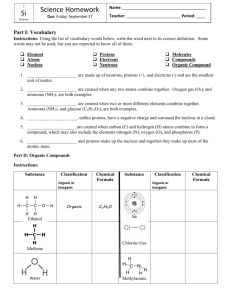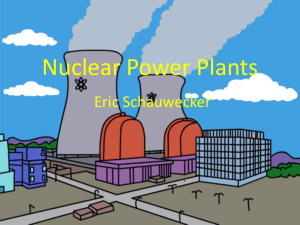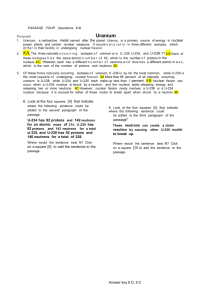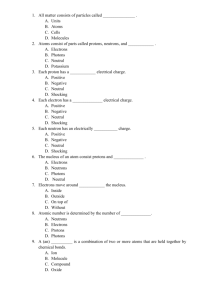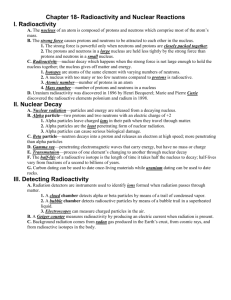Ecology Chapter 16 Notes
advertisement
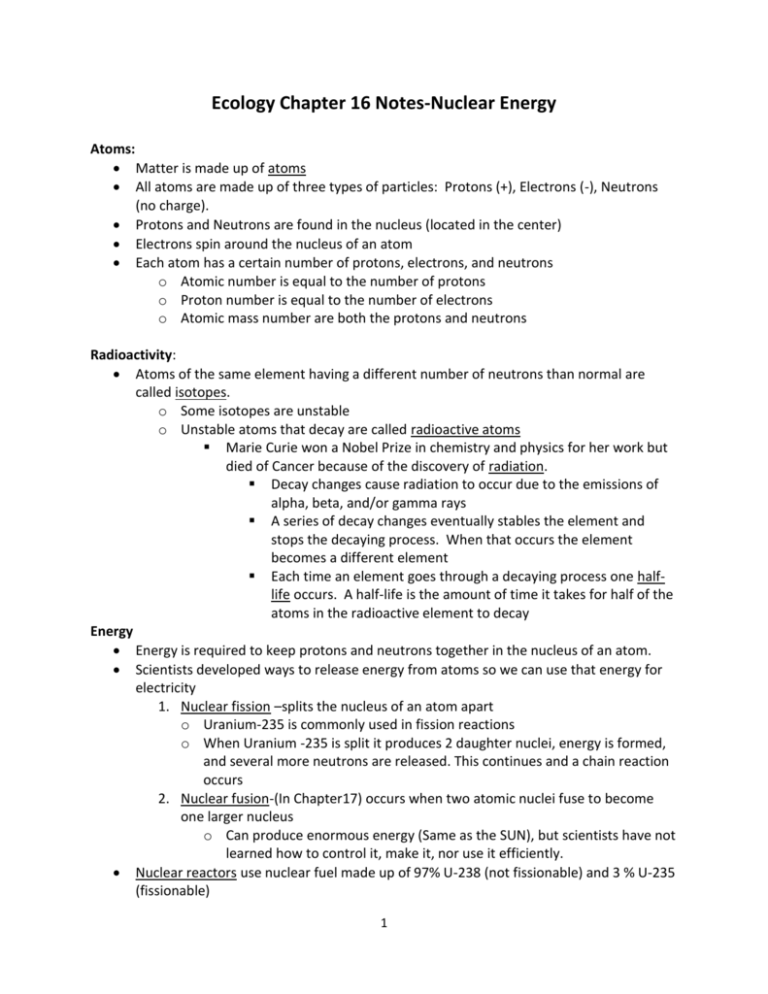
Ecology Chapter 16 Notes-Nuclear Energy Atoms: Matter is made up of atoms All atoms are made up of three types of particles: Protons (+), Electrons (-), Neutrons (no charge). Protons and Neutrons are found in the nucleus (located in the center) Electrons spin around the nucleus of an atom Each atom has a certain number of protons, electrons, and neutrons o Atomic number is equal to the number of protons o Proton number is equal to the number of electrons o Atomic mass number are both the protons and neutrons Radioactivity: Atoms of the same element having a different number of neutrons than normal are called isotopes. o Some isotopes are unstable o Unstable atoms that decay are called radioactive atoms Marie Curie won a Nobel Prize in chemistry and physics for her work but died of Cancer because of the discovery of radiation. Decay changes cause radiation to occur due to the emissions of alpha, beta, and/or gamma rays A series of decay changes eventually stables the element and stops the decaying process. When that occurs the element becomes a different element Each time an element goes through a decaying process one halflife occurs. A half-life is the amount of time it takes for half of the atoms in the radioactive element to decay Energy Energy is required to keep protons and neutrons together in the nucleus of an atom. Scientists developed ways to release energy from atoms so we can use that energy for electricity 1. Nuclear fission –splits the nucleus of an atom apart o Uranium-235 is commonly used in fission reactions o When Uranium -235 is split it produces 2 daughter nuclei, energy is formed, and several more neutrons are released. This continues and a chain reaction occurs 2. Nuclear fusion-(In Chapter17) occurs when two atomic nuclei fuse to become one larger nucleus o Can produce enormous energy (Same as the SUN), but scientists have not learned how to control it, make it, nor use it efficiently. Nuclear reactors use nuclear fuel made up of 97% U-238 (not fissionable) and 3 % U-235 (fissionable) 1 o Long rods are filled with pellets containing U-235 and the fuel rods are kept cool with water.- The U-235 will only split when in captures a slow-moving neutron o The speed is controlled by control rods made of Cadmium, Boron, or other materials that absorb neutrons. Breeder Reactors use U-238 to absorb neutrons to make Pu-239 fissionable. (Not used in USA because it is much more dangerous) Radioactive Waste Radioactive exposure is measured in rems. Most American receive between 0.2-0.5 rems per year from background radiation-like the Sun. Too much exposure can lead to diseases such as Cancer Types of Radioactive waste: 1. Large amount –high level waste 2. Medium amounts—Medium level waste 3. Low amount-Low-level waste Waste Disposal-very dangerous and very hard to dispose of because the half-lives can last for 1000’s or millions of years. o Pu-239 half-life 24,000 years o U-235 half-life 7.4 x 108 years Dangers of Nuclear Accidents When the rods are too hot meltdown occurs-The process that involves the chain reaction going out of control and melts the reactor core In April 1986 Chernobyl nuclear plant in Ukraine did meltdown-Killing lots of people and making the area unfit for life even now The Earthquake and tsunami that hit Japan in Mar. 2011 caused the meltdown process to begin there and at least 30 miles around that area is still unfit for life o Workers risk their lives to go back into the affected area and to use Sea water to stop the meltdown 2


